1lumen selects and reviews products personally. We may earn affiliate commissions through our links, which help support our testing.
Fenix TK11R review
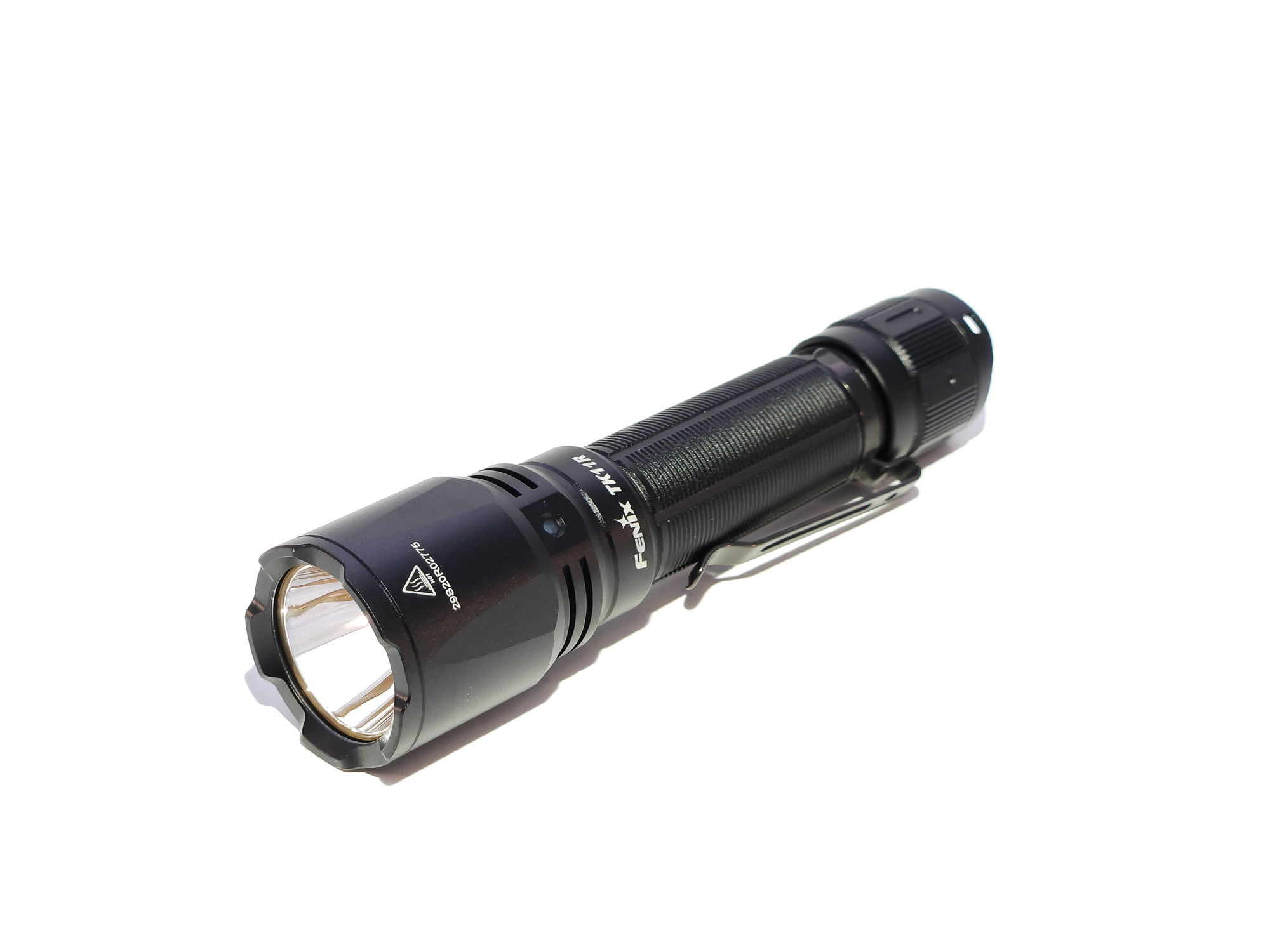
Fenix TK11R specifications
| Brand & Model | Fenix TK11R |
|---|---|
| Flashlight category | Duty / Tactical flashlight |
| LED | Luminus SFT40 6500K |
| Max. output | 1,600 lumens |
| Max. beam distance | 420 meters |
| Max. beam intensity | 45,000 cd |
| Battery config. | 1*18650, 2*CR123A |
| Onboard charging | USB-C |
| Main modes | 3 |
| Blinkies | Strobe |
| Waterproof | IP68 |
| Review publication date | April 2024 |
Review intro:
Fenix is a name brand in the flashlight world, having delivered high quality lights for well over 20 years now. Their specialities are primarily outdoor activity lights (camping, hiking, etc.) and tactical or duty lights. The TK11R is the latter. An evolution of the TK11 TAC, which we reviewed, the TK11R adds USB-C charging and an SFT-40 emitter to the large reflector design, and while the output in lumens remains the same, the TK11R claims an increase of 60% in candela and almost 90 meters of throw! That’s a tall order for an 18650, but I think the SFT-40 can do it. Let’s find out.
What’s in the package
Fenix lights come in a shelf-worthy package, which is good because they’re one of the few flashlight brands you can find in physical stores! The box is black with orange highlights and is covered with images of the light and specifications. Very useful. Inside, there’s a molded plastic tray which holds the light itself on top and the accessories underneath. It’s all one piece, so when you pull it out, the accessories don’t spill everywhere. Overall, high quality packaging.
The contents of the box include:
- Fenix TK11R, with Fenix ARB-L18-3400 18650 lithium-ion battery inside and clip installed
- Lanyard
- USB-A to USB-C charging cable
- Holster
- Instruction manual
- Warranty card
- Advertisement for the Fenix HM70R
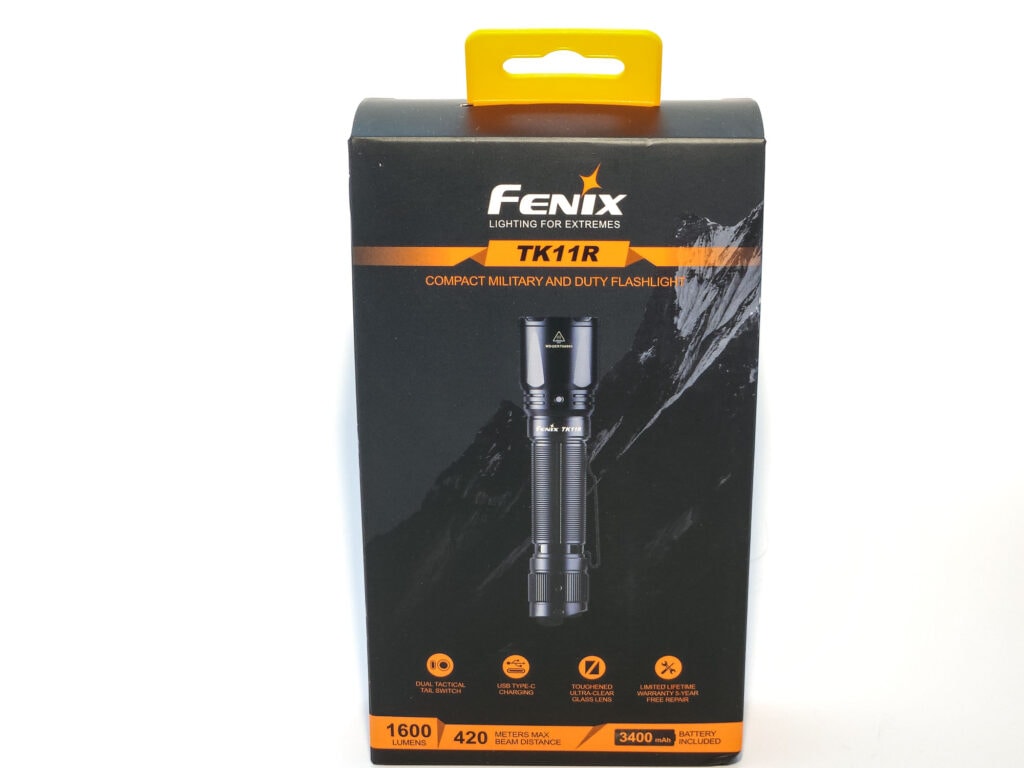
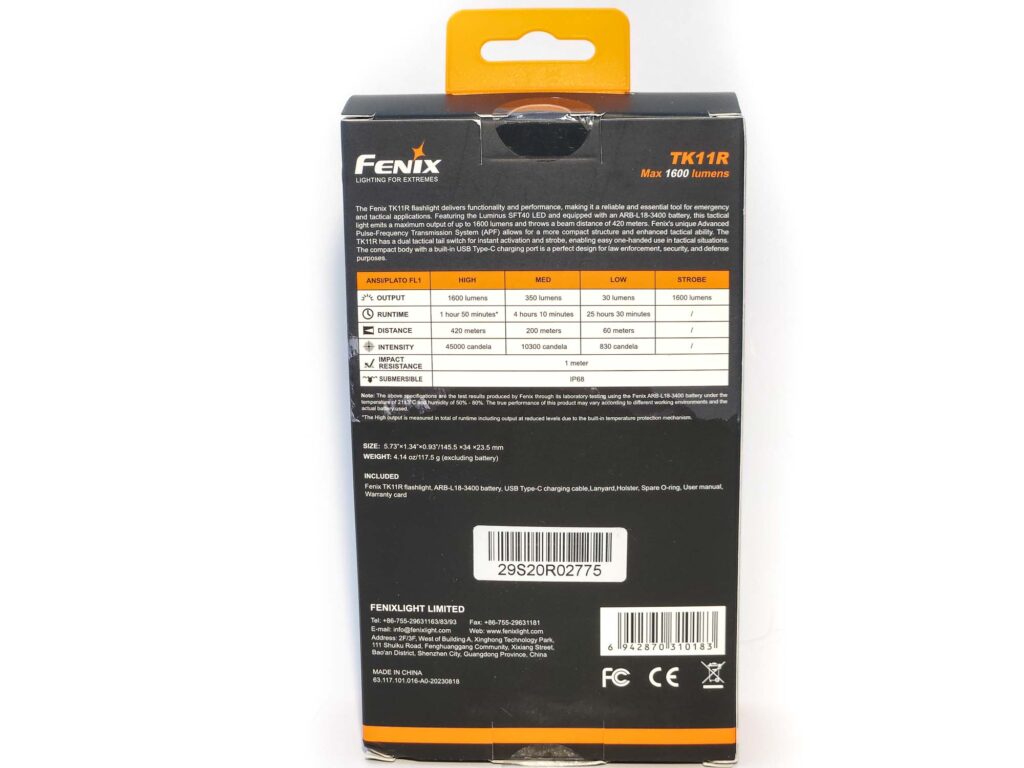
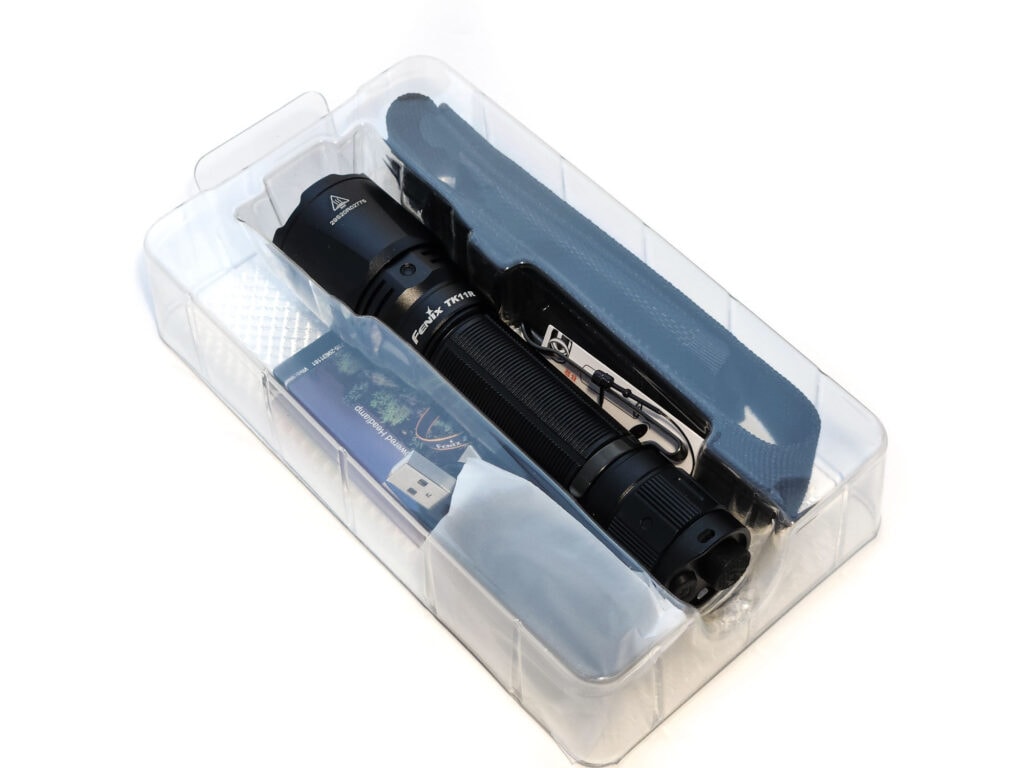
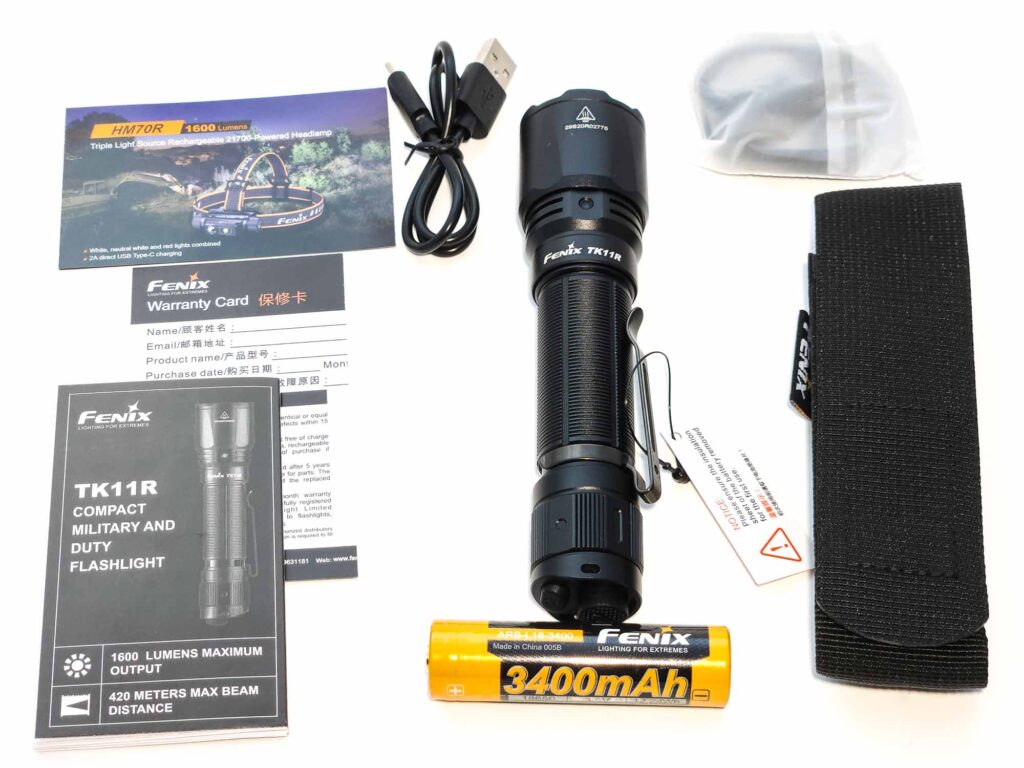
Flashlight in use, Build Quality, and Warranty
Fenix makes tough lights and the TK11R is no exception. HAIII anodized aluminum keeps it in one piece, and dual springs keep the battery connected regardless of shaking or impact for uninterrupted service. It’s an easy light to hold with or without gloves due to the ringed knurling on the body and parallel knurling on the tail cap.
The TK11R, and really all of the TK series, is a bit too large for pants pocket carry, so a holster is included. It’s a pretty simple affair; a single strip of webbing with stiff, woven nylon sides and hook and loop closure comprise most of it. Other than that, there’s a fixed belt loop and a small loop above that for attaching a carabiner or something similar on the back. It does the job and there isn’t much else to say about it. There’s also a clip included, which only holds it as deep as the tail. The clip is stiff, but the arms feel like they might come off relatively easily if it’s pulled hard.
With two buttons on the tail, the TK11R is definitely a dedicated tactical/duty light. The larger button (labeled “Tactical Switch” by Fenix) is a forward-clicky switch so you can half-press for momentary, and a click of the other, rectangular button (“Functional Switch) in an e-switch which advances modes and activates strobe when held, even when off. That about sums up a tactical light!
The buttons are easy to find by feel and unmistakable. You can get to the Tactical Switch if holding overhand from any angle, but you’ll need to have the Functional Switch under your thumb if you plan on using that. This setup is reinforced by a lip around 2/3 of the tail, but cut away near the Functional Switch. There are also two holes for the lanyard on opposite sides of the lip, and those would prevent you from being able to tail stand the light, not that it can anyway, since the larger on/off button extends past that lip.
As this is a tactical/duty light, it’s designed to be held overhand, but you can handle it other ways, too. It does memorize the last used mode, which would make it easy to have both instant strobe and instant high mode. If you wanted to take this out while walking your dog you could, but it wouldn’t be my first choice for daily use due to the instant strobe access.
Fenix uses a technology they call APF (Advanced Pulse-Frequency transmission system) which allows for a multifunction tail e-switch without the use of an inner tube or customized battery. This keeps the diameter and weight down, and allows for more freedom in battery choice. They also advertise that their thermal protection setup, which they call IOP (Internal Overheat Protection) is patented, and keeps the light below 65 degrees Celsius.
Fenix offers a limited lifetime warranty against manufacturing defects in their lights. What that means is that if the issue is within 15 days, the light will be replaced for free; if it’s within 5 years, they will repair it for free; and if it’s beyond 5 years, they will repair it for the price of the parts. However, if you buy the light from certain retailers, you will have to return it to that retailer instead of working with Fenix on warranty issues.
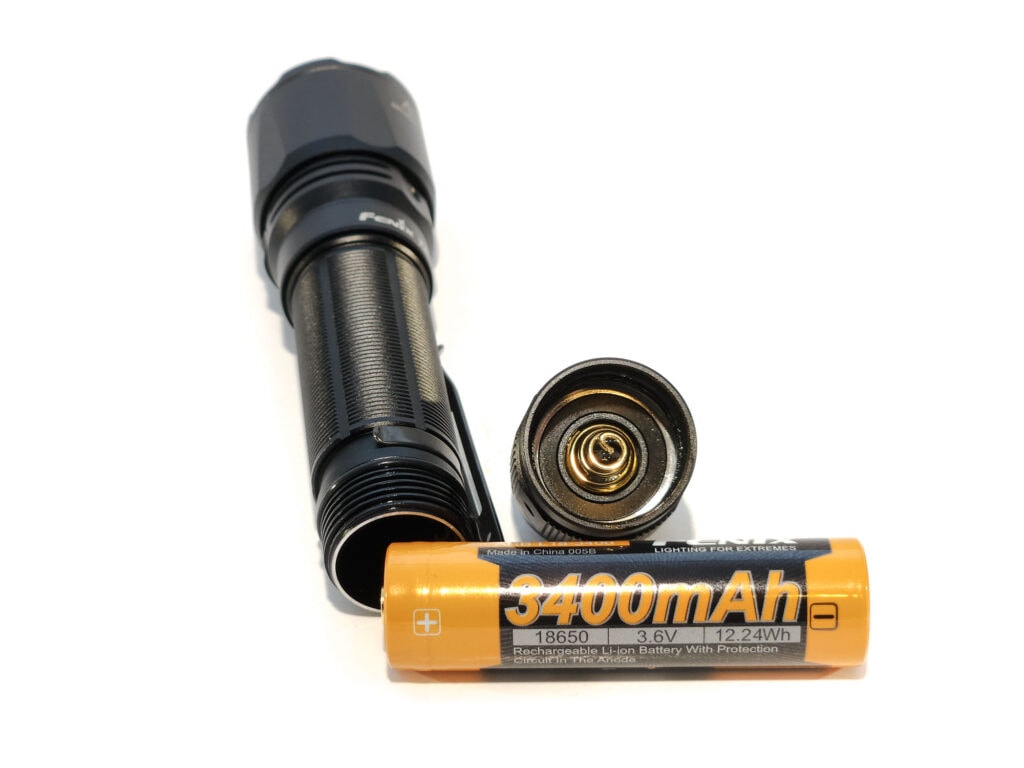
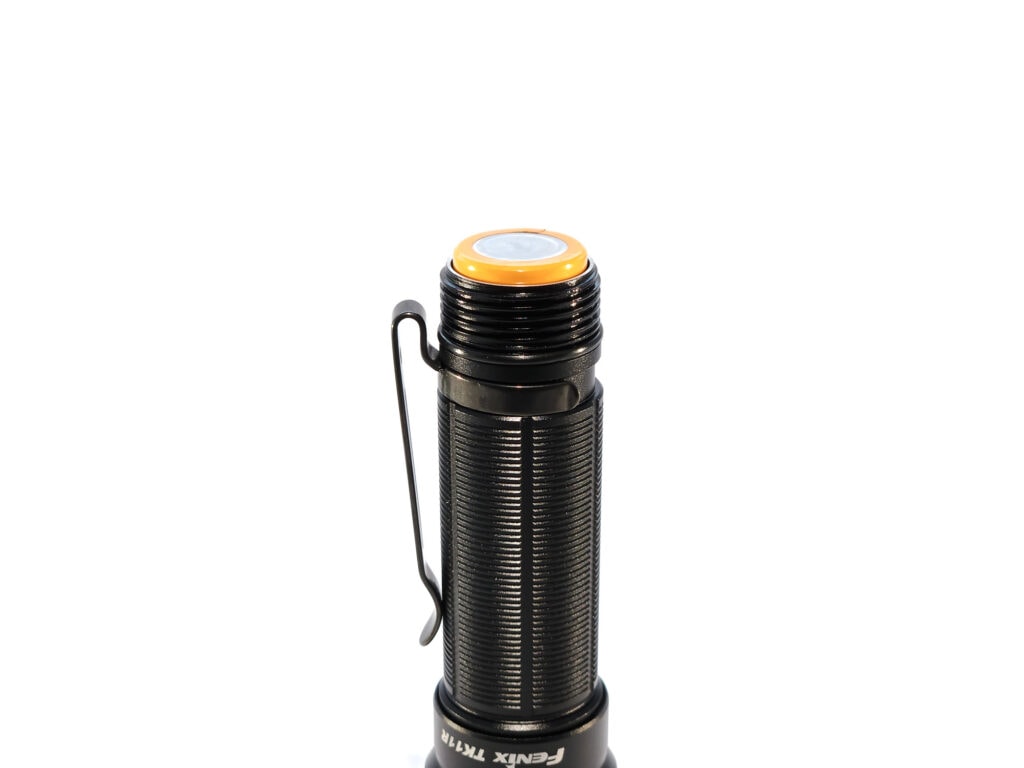
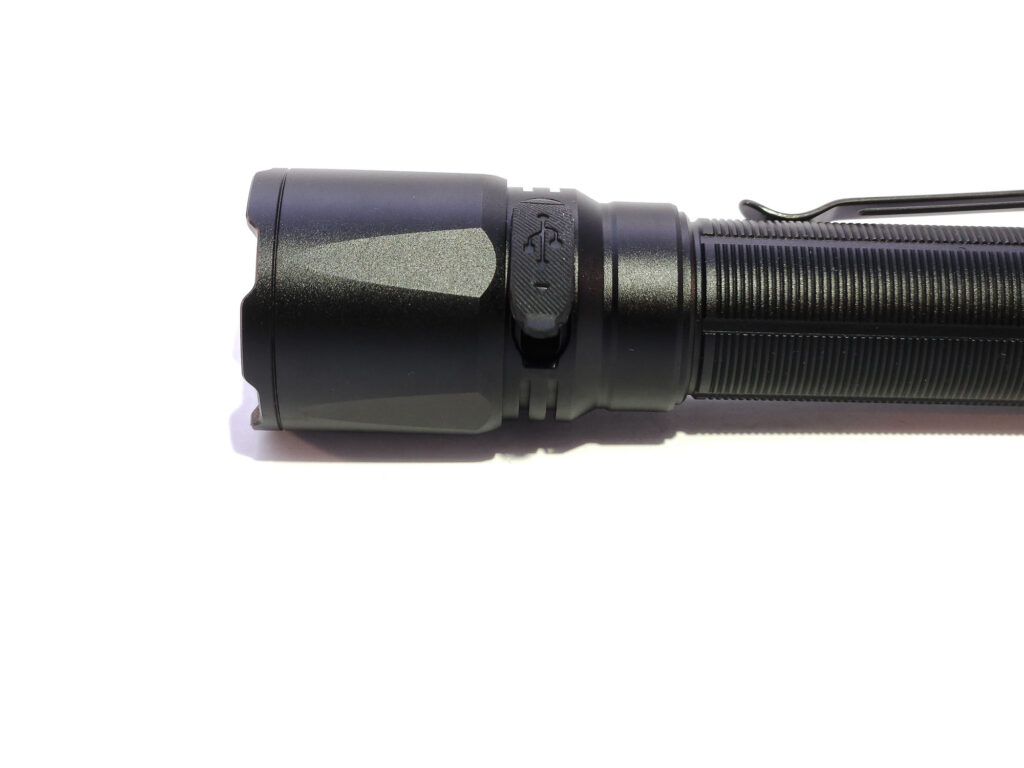
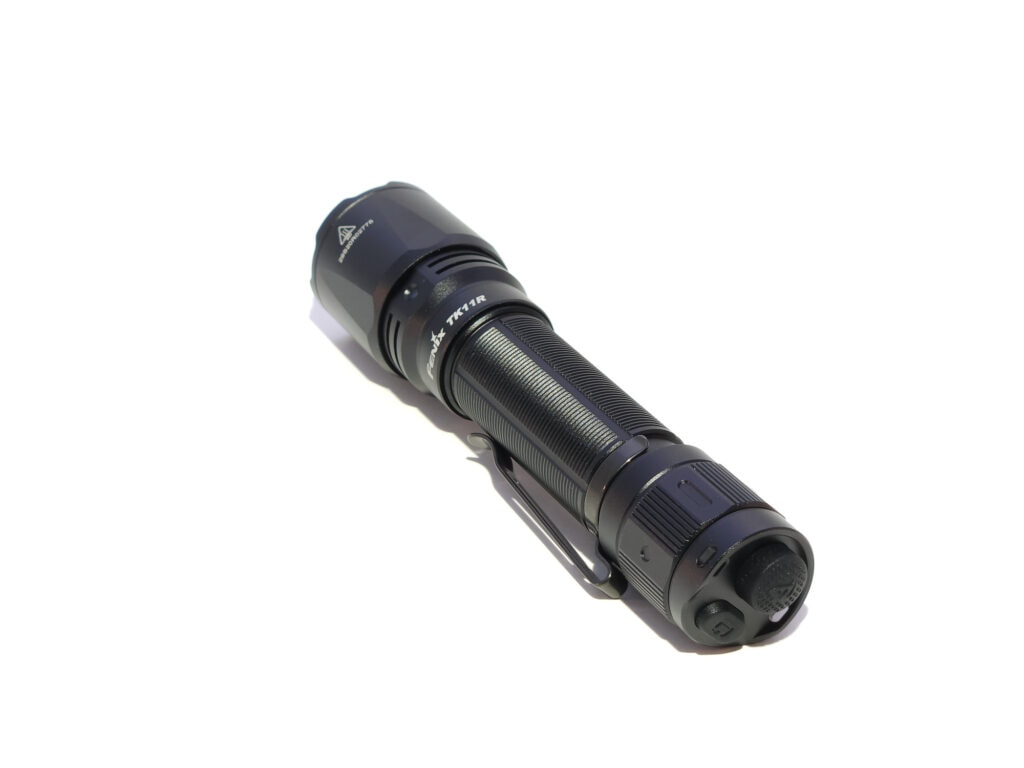
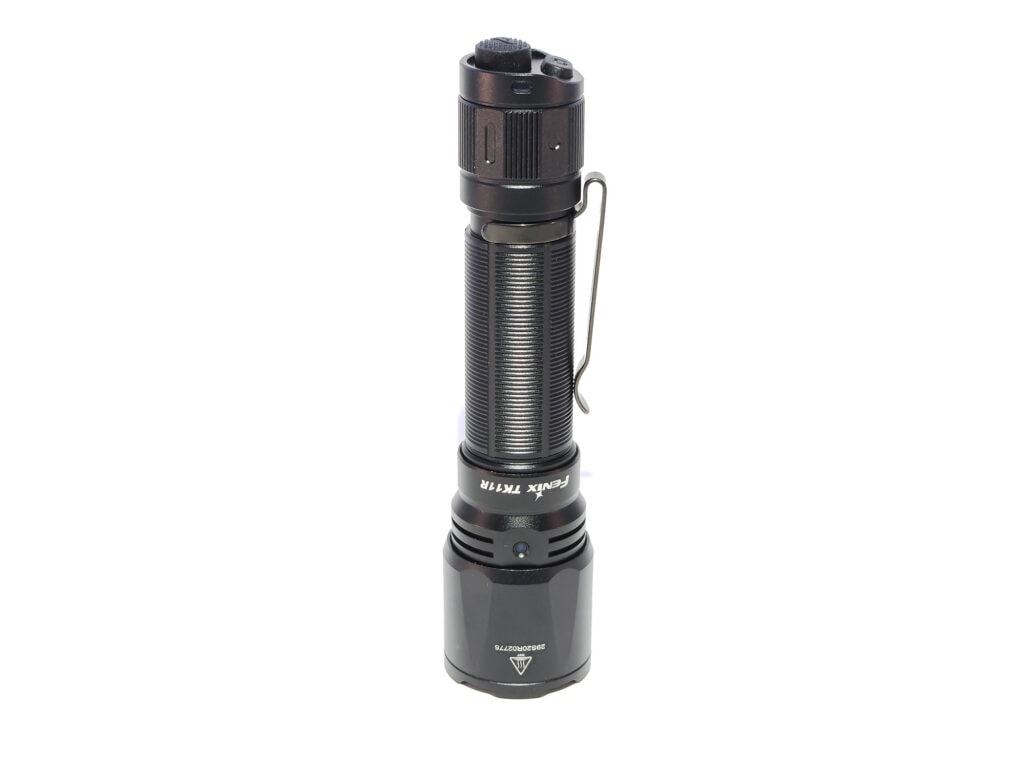
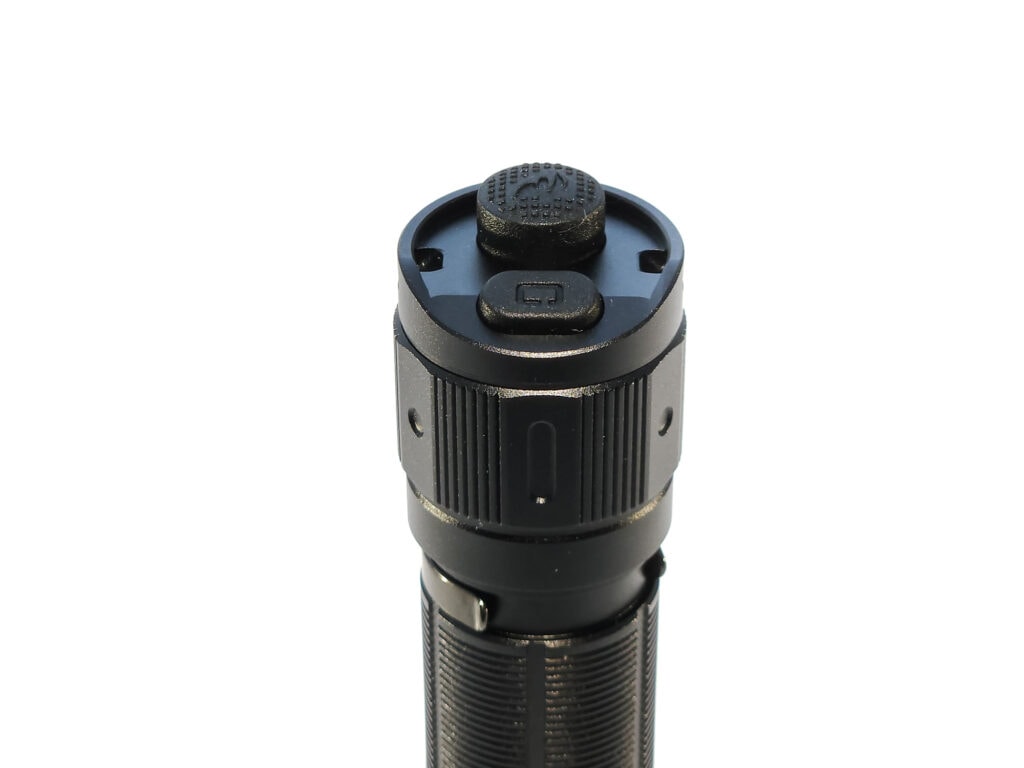
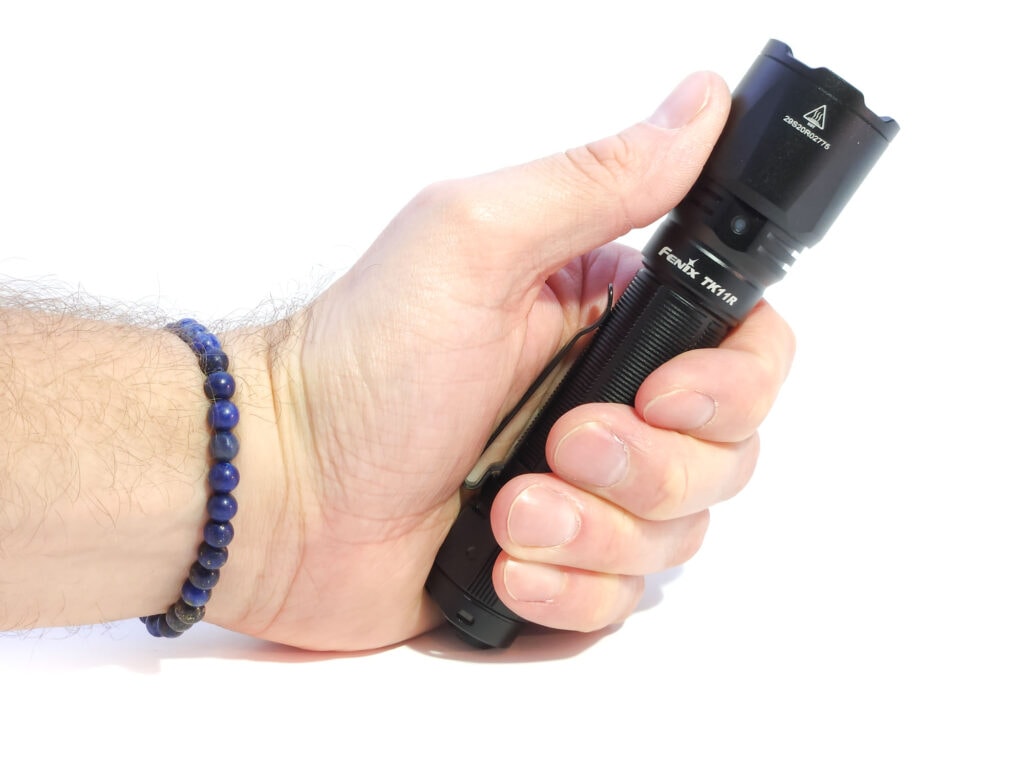
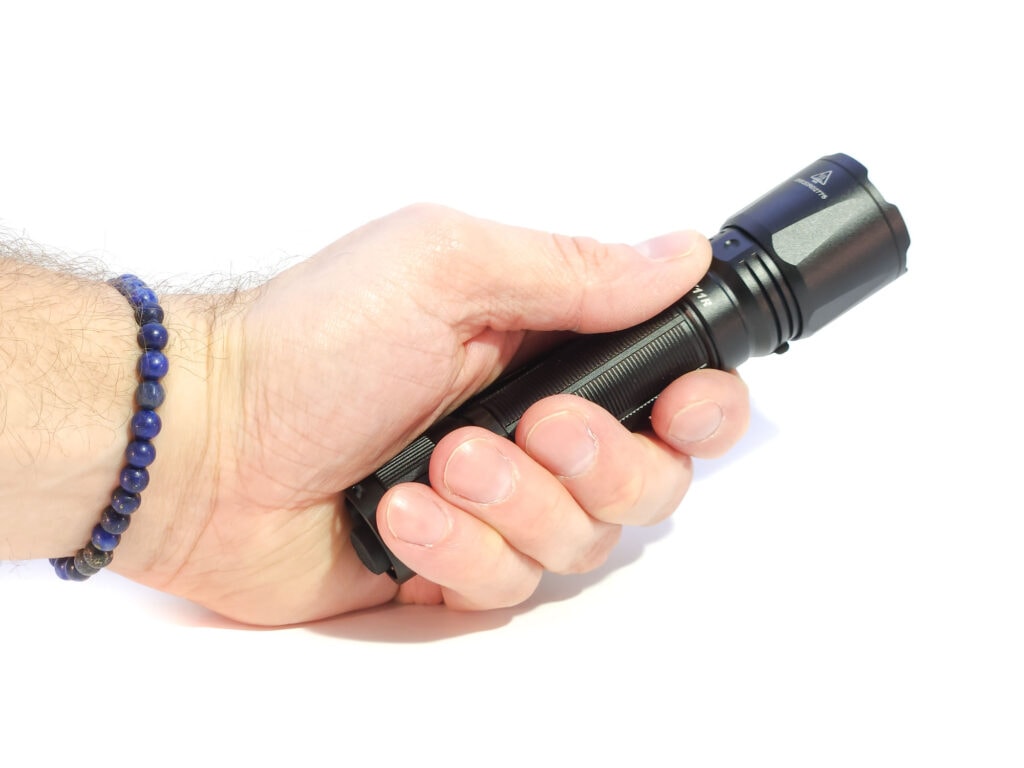
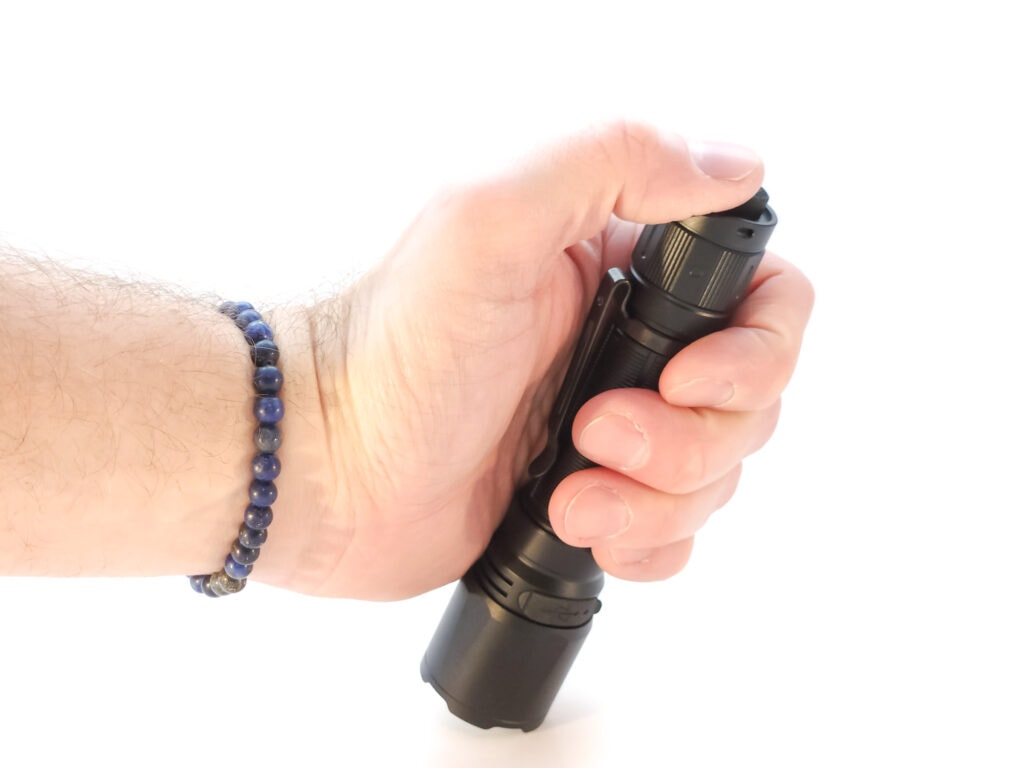
LED, Lens, Bezel, Beam, and Reflector
The Fenix TK11R is a thrower, that’s for sure. You can tell by the size of the head and the large, smooth reflector focusing the Luminus SFT40, which is throwy to begin with. I didn’t see any mention of it on the product page, but it looks like the lens has a purple anti-reflective coating on it. The bezel has some medium-sized crenulations on it.
The 6500K, low CRI SFT-40’s DUV is fairly high on low mode. This usually results in a greenish tint which you can kind of see in the edges of the corona of the hotspot, while the hotspot itself feels dull. Medium is much whiter, and high, though it still has positive DUV, has a bright, neutral white hotspot. Though the hotspot is tight, there’s a large circle of spill which is usable but doesn’t reach nearly as far as the hotspot. Again, this is a tactically-minded light, going for that intense, far throwing hotspot rather than a larger visible area, and I think it gets that done.
My Opple measurements for flicker indicated that there is some pulse-width modulation on medium, but I was unable to detect it visually.
Spectral measurements:
I used an Opple Light Master Pro to measure the flashlight at two meters distance.
| Mode: | CCT: | CRI Ra: | duv |
|---|---|---|---|
| High | 6339 K | 68.3 | 0.0040 |
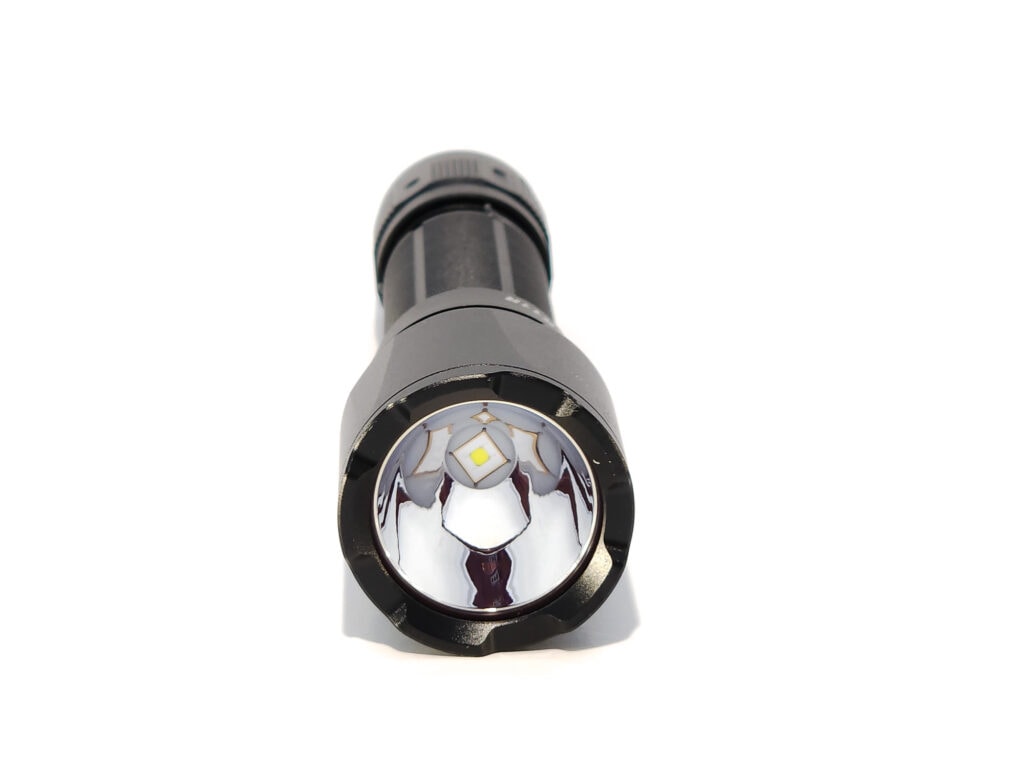
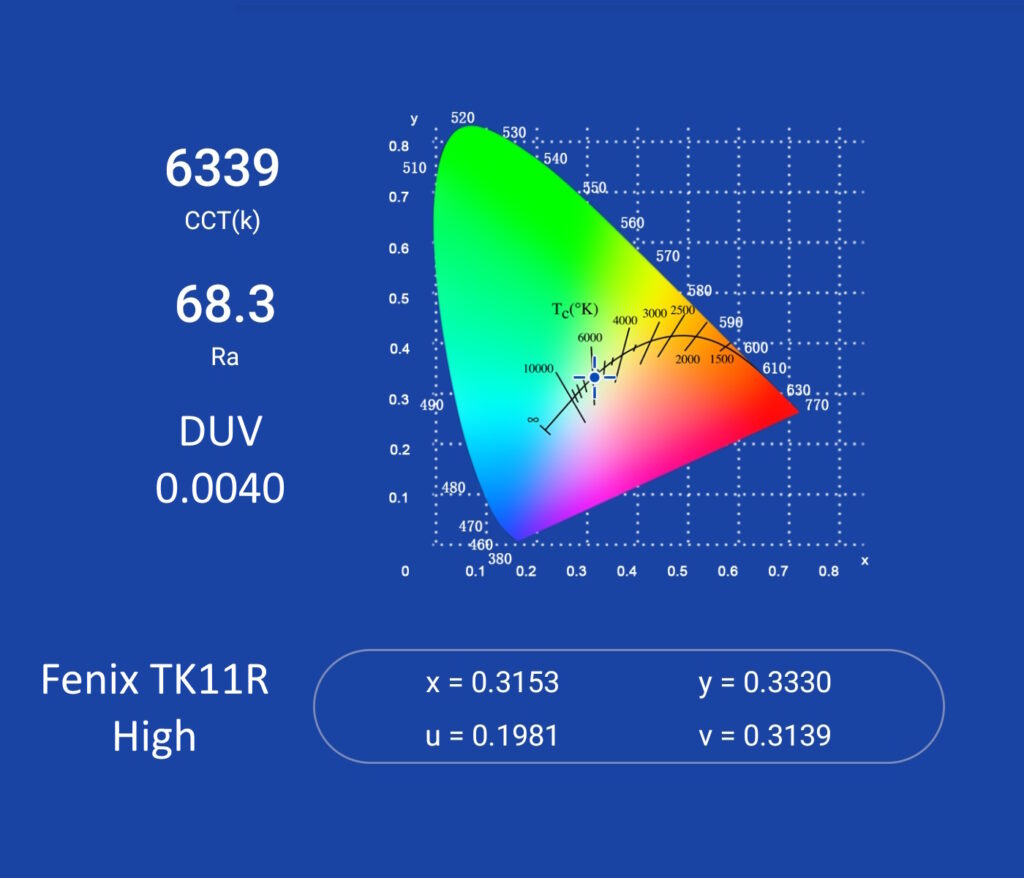
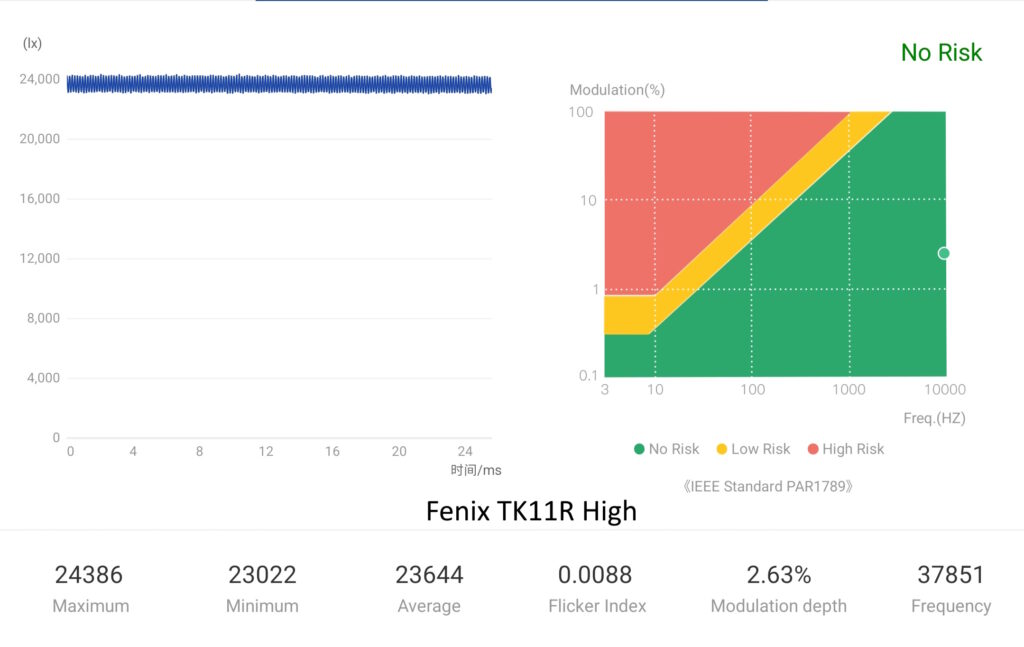
Dimensions and its competition
Dimensions:
| Fenix TK11R | Millimeters | Inches |
|---|---|---|
| Length | 145 mm | 5.7 in |
| Head diameter | 34 mm | 1.3 in |
| Body diameter | 24 mm | 0.9 in |
Dimensions are rounded to the nearest millimeter and the nearest tenth of an Inch.
Weight:
| Fenix TK11R | Weight in grams | Weight in oz |
|---|---|---|
| Without battery: | 116 g | 4.1 oz |
| With battery | 167 g | 5.9 oz |
Weight is rounded to the nearest gram and tenth of an Oz.
Flashlight size comparison with its competition:
Group 1: Emisar D4 v2, Fenix TK11R, Convoy S2+
Group 2 Tactical flashlights: Nitecore P23i, Fenix TK11R, Fenix TK22R, Nitecore SRT6i
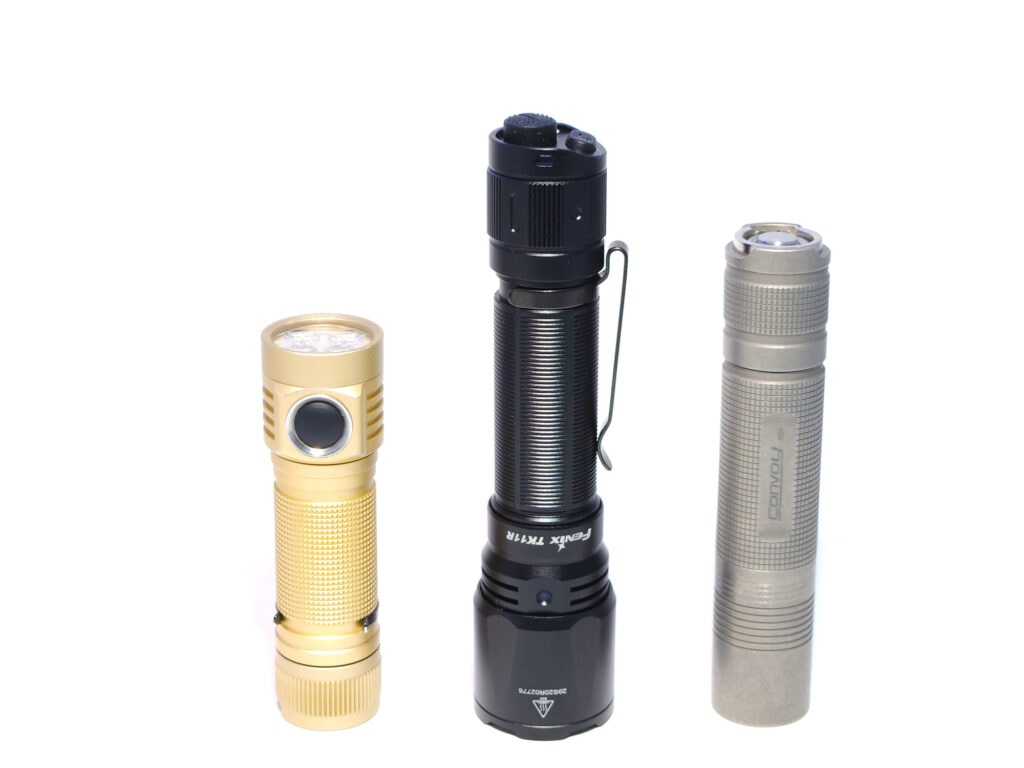
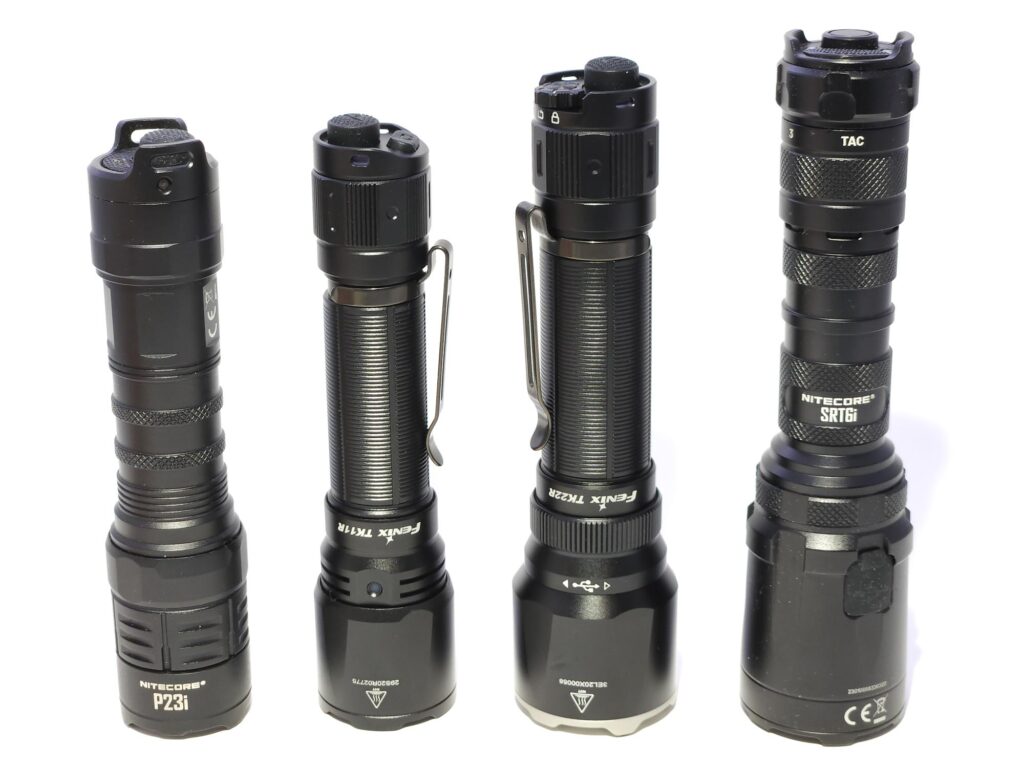
Fenix TK11R UI: User Interface and Driver
Available modes:
- Low, Medium, High
Available blinky modes:
- Strobe
From OFF: Tactical Switch:
- Press and hold: Momentary memorized level
- Single click: On to memorized level
From OFF: Functional Switch:
- Press and hold: Momentary strobe
From ON: Tactical Switch:
- Single click: Off
From ON: Functional Switch:
- Press and hold: Strobe
- Single click: Advance modes (LMH)
Mode memory:
- LMH will be memorized unless you plug in the charger or disconnect the battery, then it will go back to low
Shortcuts:
- N/A
Low voltage warning/protection:
- The emitter will blink a few times when the voltage gets low, and the battery indicator LED will flash red.
Strobe/blinkies
- Strobe is accessed by holding the functional switch from any mode, even off. The frequency changes every few seconds to presumably keep a target disoriented.
Lock-out mode:
- There is no electronic lockout, but you can loosen the tailcap to break the circuit.
PWM
- PWM is not visible with the naked eye or my phone camera
Additional/summary info on the UI:
- It’s a straightforward, simple UI, that’s all!
Fenix TK11R Charging and batteries
Fenix includes their 3400mAh 18650 battery model ARB-L18-3400 with the TK11R, which despite having built in protection circuitry, is still only 70mm long. You can use all other 18650s, protected or unprotected, in the TK11R due to there being large springs at either end of the tube. (I tested with a 73mm 18650 and it worked.) Alternatively, the TK11R can be used with a pair of CR123As.
The TK11R has onboard USB-C charging and comes with a USB-A to USB-C cable for just that task. USB-C to USB-C also works, if you have that type of charger. You cannot use the light while Charging takes about 3 hours, as advertised, though that depends on how powerful your charger is. It seems to charge at or around 1A, which is a very acceptable rate. End voltage was around 4.11 – 4.13V.
Since the TK11R can be used with two CR123A batteries, the light itself does not have low voltage protection on it as this would prevent you from squeezing every last volt out of those primaries. The included battery does have LVP, but keep that in mind if you decide to use an unprotected 18650. After my runtime tests, my multimeter was unable to get a reading on the voltage until I put it on the charger or plugged the light in. After that, it measured as low as 2.58V.
A 250 mA capacity test on my Vapcell S4+ returned 3128mAh. In my opinion, that’s a bit low to call it a 3400mAh battery. I do have another ARB-L18-3400 which was much closer to 3400mAh, but still under.
| Charge type | Fits | No fit | Charge time |
|---|---|---|---|
| Flashlight with onboard USB-C | All 18650s / 2*CR123A | N/A | 3 hours |





Performance test
Lumen measurements
How Lumens are Measured: Understanding ANSI FL1 Standards How Lumens are Measured: Understanding ANSI FL1 Standards: The ANSI FL1 standards specify that output in lumens should be measured 30 seconds after turning on, as this is the standardized time for measuring brightness according to the industry standard. This is why we focus on this part in our measurements. The ANSI FL1 standards require an ambient temperature of 22 ± 3°C. We record the ambient the ambient temperature to identify potential reasons for any observed discrepancies.To obtain these numbers, I used an integrated sphere and Extech SDL400 data logging lux meter. Measurements have been calibrated using a standardized calibration light provided by 1Lumen.
Each of the three modes came in lower than expected, with high taking the biggest hit. Once high steps down, you’ll still have ~600 lumens for half of the total runtime before it steps down again. So aside from the turbo-like boost of the initial high output, you’ve really got (approximately) 600, 300, and 30 lumen modes. The thing is, though, that you’re not really going to be able to tell the difference between 1600 and 1269 lumens visually anyway.
| Mode | Specified | Turn on | 30 sec. | 10 min. |
|---|---|---|---|---|
| Low | 30 | 25 | 25 | 25 |
| Med | 350 | 305 | 304 | 301 |
| High | 1600 | 1269 | 1204 | 591 |
| Turbo at 3.6V | – | 891 | 856 | 613 |
Ambient temperature during testing:
- 21°C
I was unable to measure the idle draw. No matter what mode I set it to before removing the tailcap, it would only turn on to high and measure between 3.5 and 4 Amps.
Fenix TK11R Battery Life: Runtime graphs
How Runtimes are Measured: Understanding ANSI FL1 Standards About ANSI FL1 runtime standards: The runtime is measured until the light drops to 10% of its initial output (30 seconds after turning on). This does not mean that the flashlight is not usable anymore. The last column shows how long the light actually works till it shuts off. If there is a + symbol, it means that the test was stopped at that particular point, but the light was actually still running. This happens on certain occasions, with certain drivers, firmware, or batteries.To obtain these numbers, I used an integrated sphere and Extech SDL400 data logging lux meter. Measurements have been calibrated using a standardized calibration light provided by 1Lumen.
| Mode | Specified | Runtime (ANSI FL1) | Time till shut off |
|---|---|---|---|
| Low | 25h 30min | 29h 30min | 29h 42min |
| Med | 4h 10min | 3h 58min | 6h 21min |
| High | 1h 50min | 1h 33min | 3h 51min |
Overall, the ANSI runtimes came up short against the specs, but you will certainly get a long runtime before it finally cuts out due to the lack of LVP on the light itself. That is, if you only need about 20-30 lumens.
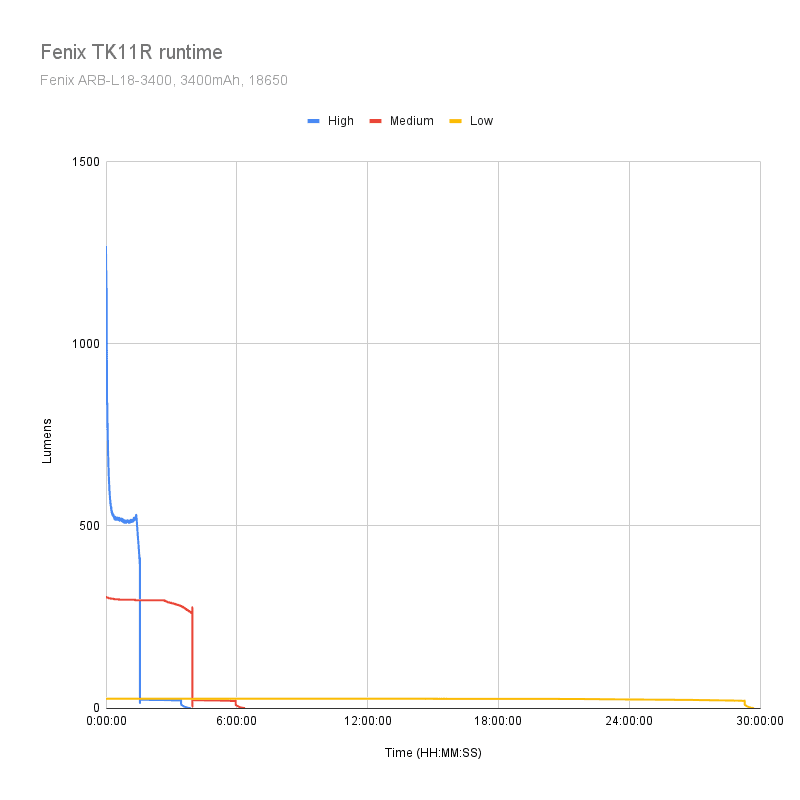
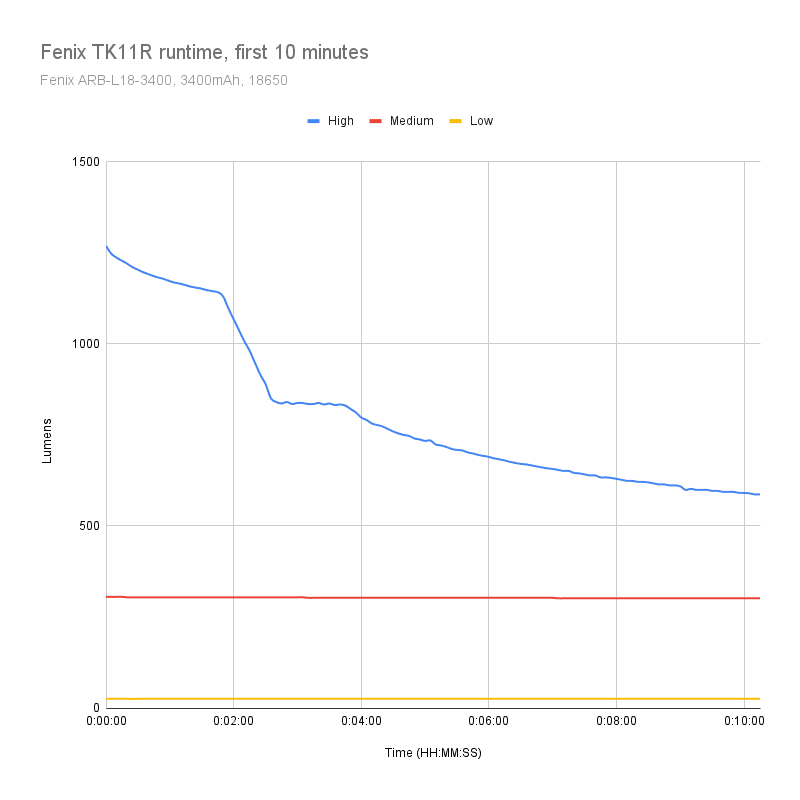
Peak beam intensity and beam distance measurements
About Peak beam intensity: Understanding ANSI FL1 Standards About peak beam intensity The calculated value of distance in meters at which the flashlight produces a light intensity of 0.25 lux. (0.25 lux is about the brightness of a full moon shining on an object). This means that the intensity has decreased so much, it becomes difficult to see darker objects, or objects that don’t reflect light. The columns ‘Meters’ and ‘Yards’ use rounded numbers.The numbers for candela were obtained with an Extech SDL400 data logging lux meter at 5 and 15 meters, then averaged.
| Mode | Specified | Candela measured | Meters | Yards |
|---|---|---|---|---|
| Low | 800 cd | 1095 cd | 66 m | 72 yd |
| Medium | 10,300 cd | 13,764 cd | 235 m | 257 yd |
| High | 45,000 cd | 55,055 cd | 469 m | 513 yd |
Fenix lights tend to come in higher for candela and throw, especially the TK series, and the TK11R does just that. Quite a bit, in fact. A good mark for a tactical light.
Ambient temperature:
- 21 °C
Beamshots
Camera settings and distance: These were taken with a Samsung Galaxy S22+ using pro mode and the following settings: 0.5sec, ISO200, 5000K
Distance to the other end of the playing field is 100 meters. You can see how the TK11R can light up the other side of the field even in medium.
Beamshots of the following flashlights compared:
- Fenix TK11R
- Fenix TK22R
- Nitecore P23i
- Nitecore SRT6i
Please note that the following beamshots are mainly intended to showcase the beam pattern and beam quality, rather than overall performance. These images are typically taken directly after activation, and in different seasons or weather conditions, and therefore do not fully represent its overall performance. For accurate performance metrics, such as output, beam distance, and runtimes, you need to look at the performance section of this review.
The camera settings for the following TK11R beamshots were slightly changed by the built in phone software. Therefore focus mainly on the beam quality rather than its brightness.

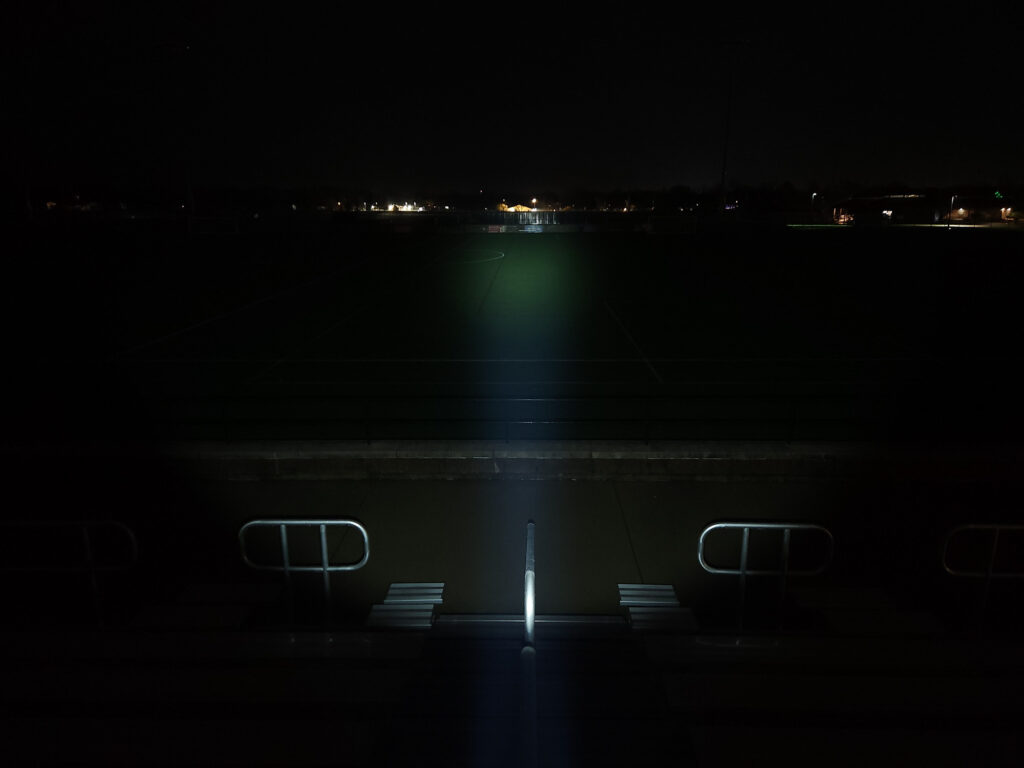
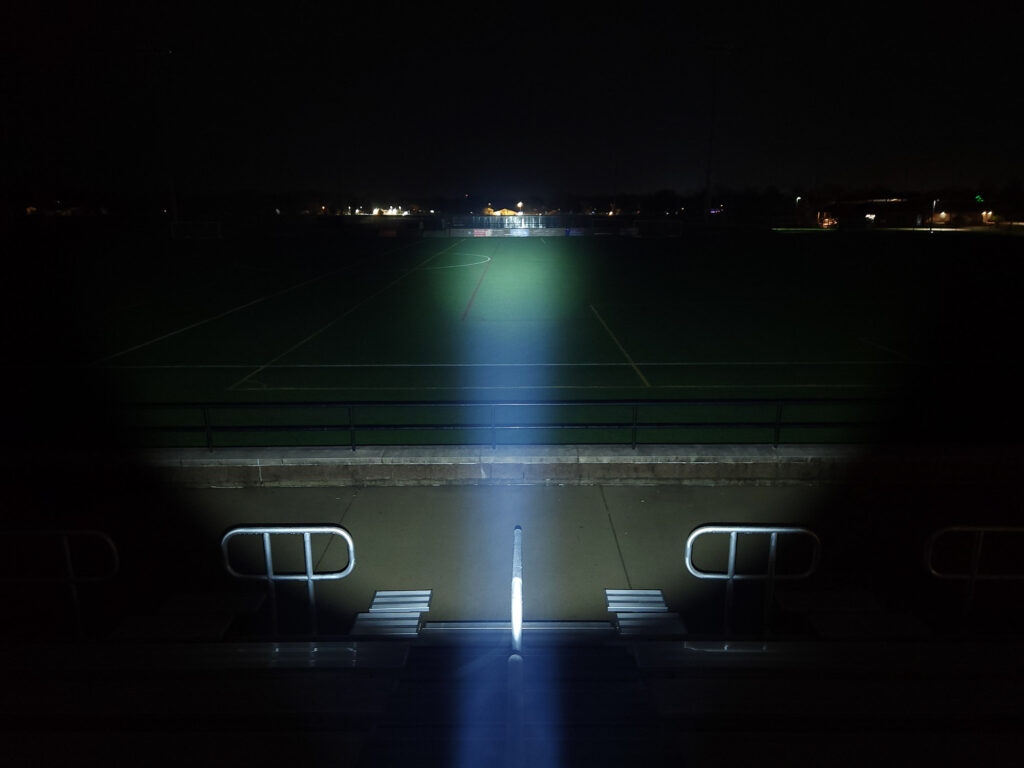
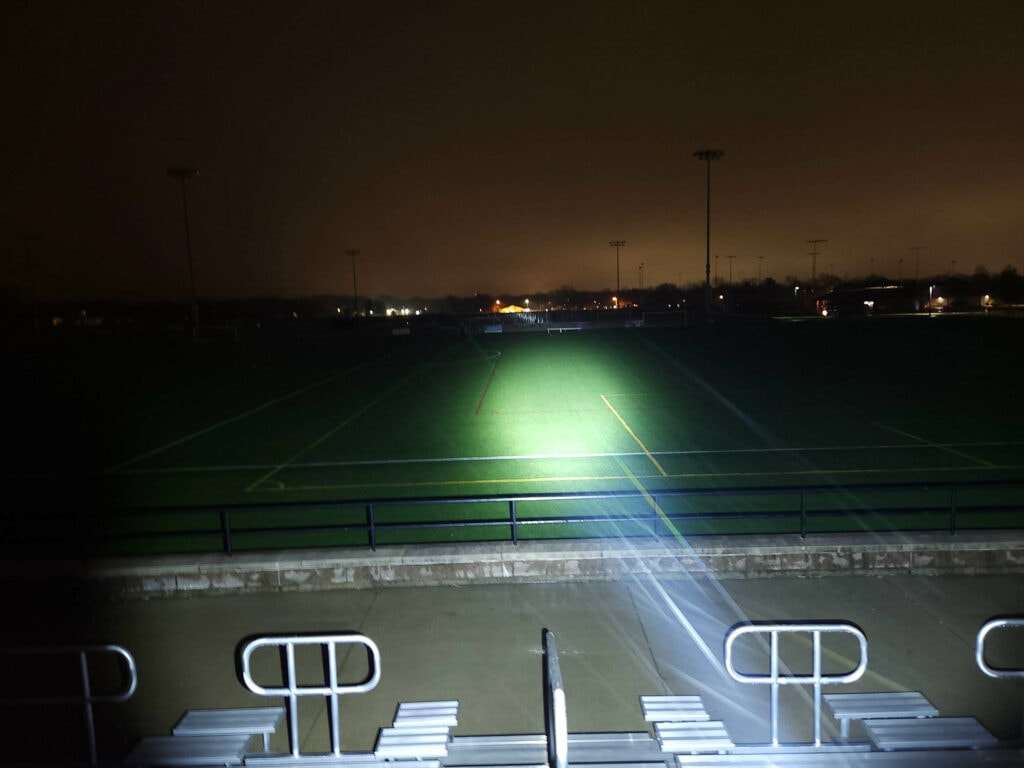
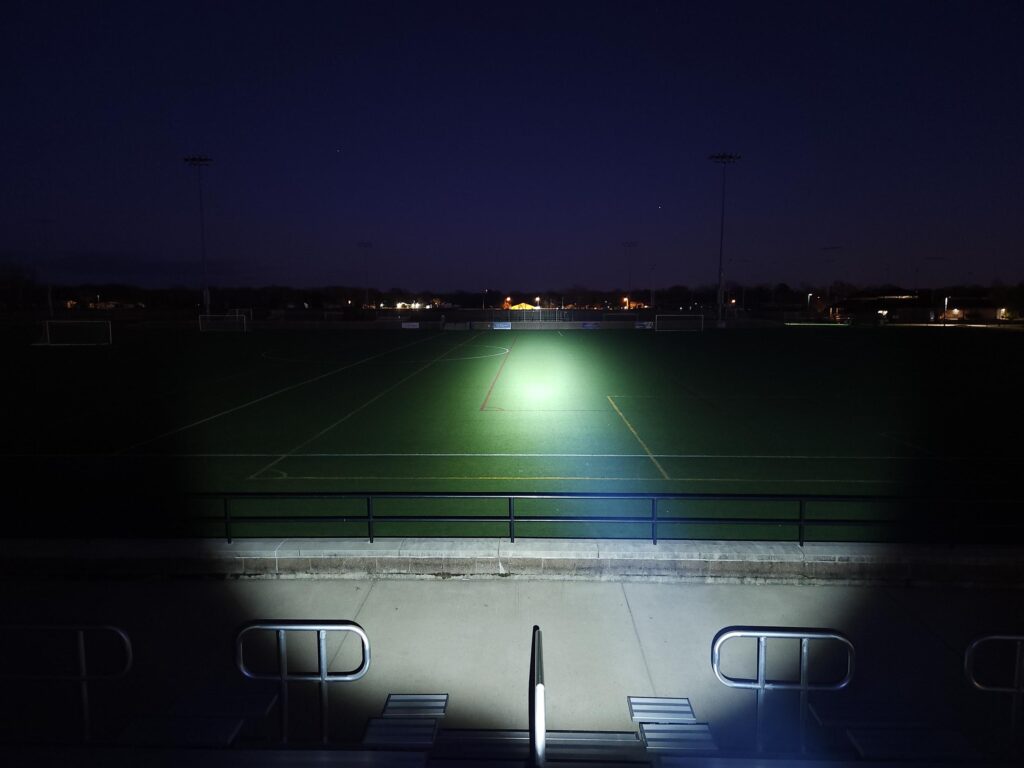
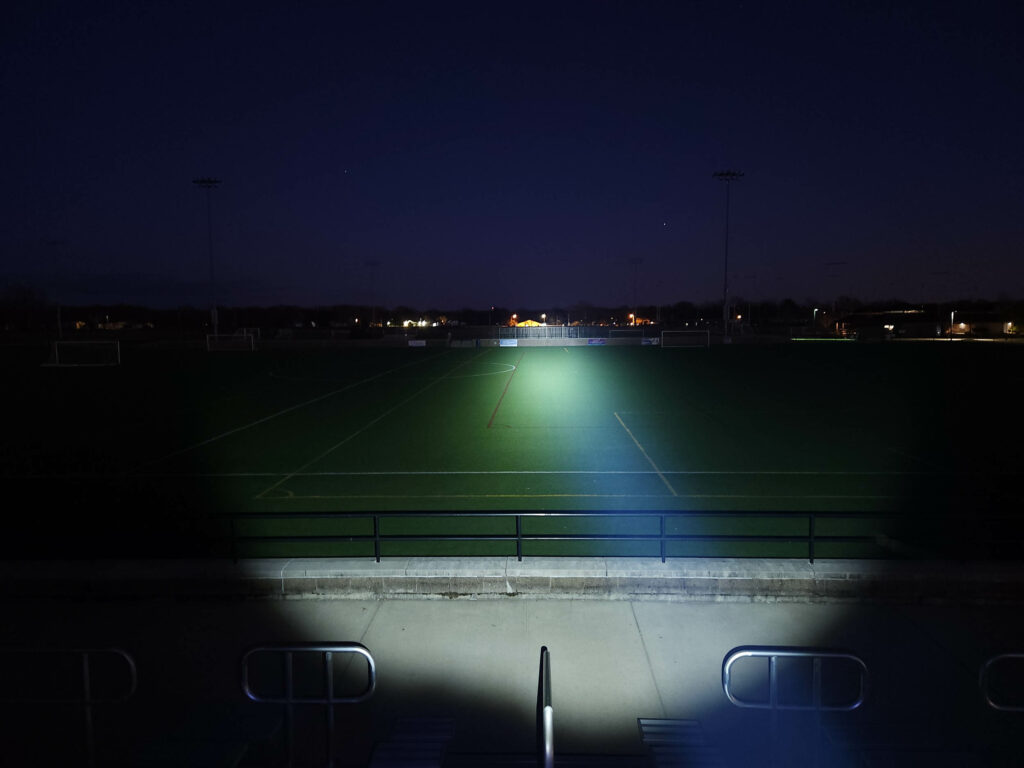
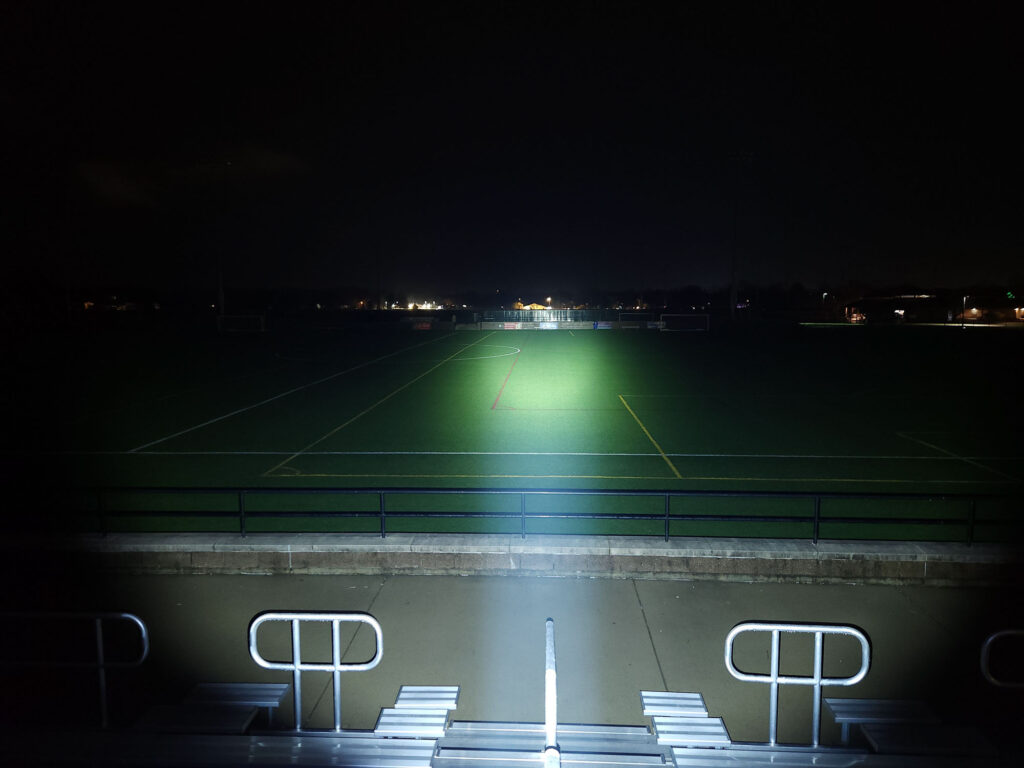
Disclaimer: This flashlight was sent to us for review at no cost by Fenix Lighting US. We have not been paid to review, nor have we been holding back on problems or defects.
Final Verdict
Pros
- Instant access to high and strobe
- Simple UI
- Advanced e-switch on the tail without the need for a proprietary battery!
- Lots of candela in a small package
Cons
- Lumens and runtime/battery capacity below spec
Explanation on star ratings:
1: Avoid: a match would be a better choice – 2: Poor: significant defect or issues; almost unusable – 3: Average: some defects or issues; but still usable 4: Good: recommended (minor issues) – 5: Great: highly recommended

5 stars: ★★★★★
While our star rating provides a reliable indicator, we encourage you to read the full review to make an informed decision based on your own needs and preferences.
Fenix’s TK11R comes from the company’s strong TK line of tactical lights, and it lives up to its heritage. The easy to operate dual switch setup allows for quick and instant access to high and strobe, including momentary without having to stop and change modes. This is one of the key features of a real tactical light, as opposed to other companies calling anything with a tail switch “tactical”, and sets the TK11R above those.
It’s true that the output wasn’t as advertised, but 1. you won’t really be able to tell the difference in lumens by looking, 2. runtime is dependent on the battery you get/use with yours, and 3. the TK11R really does excel in candela/throw thanks to the SFT-40 emitter. If you’re in the market for a tactical light, I see no reason why you shouldn’t include the TK11R in your search, and for that, I give it a five star review.
Buy your Fenix TK11R with a discount
Get 10% off every purchase at Fenix Lighting US, by using our exclusive 1lumen discount code: 1lumen10
1lumen selects and reviews products personally. We may earn affiliate commissions through our links, which help support our testing.